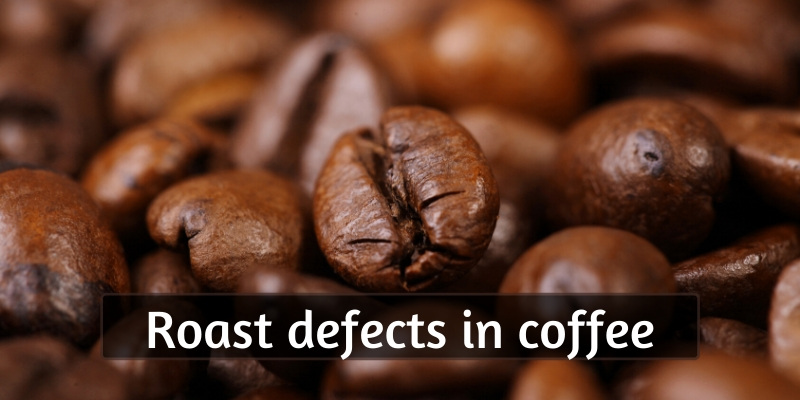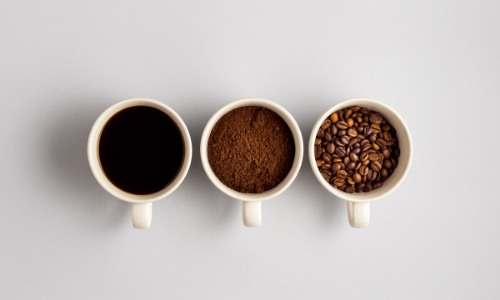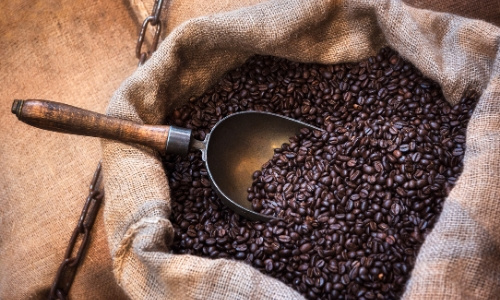The roasting process has been through a lot of changes. From the conventional dark roasting procedure to the newest era of light roast, the coffee beans experienced a significant metamorphosis.
In this article, we'll talk about roast defects and how to identify them in a cup. The roasting procedure is a highly complex process that requires a lot of knowledge about green beans and the chemistry behind it.

Table of Contents
A short look at the roasting process
During the roasting process, some things are transformed inside the green bean. These changes are the main factors that can ruin a batch of coffee.
- Structure, density, and brittleness. CO2 and other elements exert pressure inside the green bean, transforming its internal structure significantly. From hard and rough, it becomes brittle, less dense, and more porous.
- Weight and humidity. The weight of the green beans decreases by around 15-20% as the moisture and organic substances evaporate. The bean also sheds its silvery skin almost completely, you'll notice hints of it on the middle crack (lighter color).
- Color. As the sugars are caramelized and the cellulose carbonized, the color turns from the green to the usual "brownish" of the perfect roast.
- Volume. The pressure used by the gases from inside the beans increases their volume by between 40% and 60%. This means the beans themselves grow a little larger as well.
- Loss of organic compounds. Sugar and water content can drop significantly. The caffeine content persists almost unchanged.
- Aromas and oils. At the same time, roasting releases hundreds of volatile odorous compounds through pyrolysis. The longer the roasting process is, the higher the number of oil droplets that appear on the surface of the bean.
As I mentioned before, this is a short look at what is happening during the roasting process. From 25° C/77 F to almost 240° C/464 F in some circumstances, the bean experiences all of these changes.
We're doing an overview of these facts because it's simpler to understand the roast defects when you realize what is changing inside the bean. Each of them can influence the quality of coffee beans.
Most common roast defects in coffee
Mistakes happen all the time. With so many variables in the roasting process as all the chemistry changes, temperature, time, profile roasting, and so many others, it's common to make errors. Here are the main ones you're likely to find.
Overdeveloped
Here is a subtle line between dark roast and overdeveloped roast. In general, an overdeveloped roast will have a particularly dark color with a lot of oil on the surface of the bean. The taste will be burnt and smoky with aromas of chemicals or pipe tobacco.
Tip: Sometimes a good roast can have overdeveloped beans. During the process, some beans will roast a little bit faster than others. You can remove them when you are grinding a small quantity, otherwise, they will ruin the taste of the coffee.
Underdeveloped
Here is another typical error that can happen. The sugars are not caramelized enough, or the CO2 is not well developed inside the bean.
This will produce a "grassy" texture of coffee. When you are cupping, you will notice that the crust is not likely to form.
The taste will be like hay, grass, oat, corn, lentil, and so on.
This kind of error happens out of a desire to roast lighter. Or the temperature was not controlled properly during the process. Or something in the process was done wrong.
These two roast defects (overdeveloped and underdeveloped) are pretty easy to spot. One is quite dark, and one is too light brown.
Scorched
This is a roast defect that is at the same time underdeveloped and burnt. That is the result of a too hot drum and slow rotations of the roaster machine. Aromas and oil will be too heated and the taste will be a mix of scorched, grassy, and bitter. The beans will be ashy, but not developed enough.
Baked
Here is a roast defect that can't be obvious to identify. It requires a subtle taste skill. There are some reasons for this error as too much time until the first crack or too weak energy in the first place.
The taste will be baked like with notes of yeast or oat. Also, it can be felt sharp or pungent.
Quakers
This isn’t a roast defect, but usually, you’ll only find it after roasting. There are unripe beans that are difficult to identify during sorting and green bean inspection. This can be generated by weak soil conditions that limit sugars.
The taste will be dry, papery, acrid with notes of resinous.
These are the most common roast defects that can be found quite easily in a cup. Some of them can be done by the wrong profile roast, or just by accident.
How to find those defects when cupping
Cupping is the method used to taste coffee and evaluate it. It is the best technique to determine roast defects, beans defects, and specific notes. So here is a short look at the roast defects and how to find them when cupping.
Overdeveloped - The color of grounded coffee will be too dark, and in the crust will be simple to notice particles of oil. The aromas will be more like in the dry distillation zone (carbonyl, spicy, resinous) and the notes will be more like pepper, piney, smoky, ashy.
Scorched - Despite the beans being dark, the taste will be quite distinct from overdeveloped roast defects. That because the beans are not developed enough, but still burnt.
The color can be similar to the overdeveloped defect, but the crust will not have oil. The aromas will be more like a pungent smell with notes of clove, thyme, or camphoric taste.
Underdeveloped - It is not always obvious to determine this roast defect just by sight. The color can be light brown, but still a good roast.
To identify these beans it is required to smell and taste the coffee.
First of all, the crust is less likely to form.
Secondly, the aroma will be more like spicy, grassy, or medicinal and the notes will be more like sour, astringent, and sharp.
Baked - During cupping, this roast defect can be felt just by taste. The notes will lose more of their acridity, sweetness, and warmth of flavor as they cool. Also, you can find notes of yeast, baked-like, and raw-like.
Quakers - The beans will be lighter than the rest of the coffee beans. They are not developed well, and this will result in notes of cereal and papery with dry after taste.
These are the main roast defects that can really make a cup of coffee bad. There many other factors that can ruin the coffee experience like beans defects, bad extractions, poor water, and so on but we'll get to them in another post.
A poor roast will ruin the experience
One green bean contains more than 1000 different ingredients.
Caffeine is the most prominent, but the most important components are carbohydrates, fats, water, proteins, acid, alkaloids (caffeine), minerals, and aromas.
By weight, carbohydrates make up the largest portion. These are transformed during the roasting into other chemical compounds or completely broken down.
Fats and oils are other very important sources of flavor.
Also, acid plays an essential role in taste. During roasting these are developed, and in some cases destroyed. The more is roasted, the more bitter substances are created.
Overall, all of these different ingredients can transform a batch into a great roast, or something bitter and harsh with defects. It easy to make mistakes in the process, that's why roasting is the main factor that determines the quality of coffee.
If something happens with the roast, then everything is off. The barista will no longer be able to extract the best in the coffee, and the beverages will not be at their highest potential.
Also, many people brew coffee at home, and it can be very frustrating for them to get a poor coffee. A lot of them can experience a bad roast even if they don't perceive that. That's why everyone must understand the basics of roast defects and recognize them by tasting.
A good roast can bring out the best
And of course, a good roast can provide a pretty good experience to the customers. A good roast can be quite easy to identify in cups. It will have aromas of flowers or fruits and notes of good stuff like chocolate, forest fruits, oranges, and so on.
What else can ruin a good coffee?
Besides roast defects, many other variables can ruin a good coffee like natural beans defects, poor water, inadequate extractions. Sometimes all of these meet in the same cup and this is just a very bad cup of coffee.
A short look at the bean defects
A good roaster will take some time to re-check if there are beans defects before roasting them.
A lot of roast defects can happen primarily because of bean defects. But, since they're fairly easy to spot you can remove the bad beans before you roast them.
Or, if you notice they're bad and roasted you can still remove them before grinding your coffee.
Here is a short list with bean defects that can be removed after roast for a better experience. There are many others, but they can be noticed before roasting.
Shell and broken beans. These are not whole beans and they look like a bean with a hole. It's a natural defect but can ruin a cup of coffee. Usually because they are half beans, they will roast quickly and will produce a bitter, harsh taste with low acidity.
Gnawed beans, by insect infestation. Like many other seeds in the fruits, coffee beans can be eaten by pests. This too is natural thing but can produce a bad, bitter taste. It looks like a normal bean but with very small holes on the surface of it.
Unfortunately, just these two beans defects can be accessible to find after roasting. All other defects can be removed just before the roast. But it's still a good idea to remove them when preparing coffee.
If you want to know more about coffee or tea, feel free to check the related articles below. Who knows what else you might find ?







